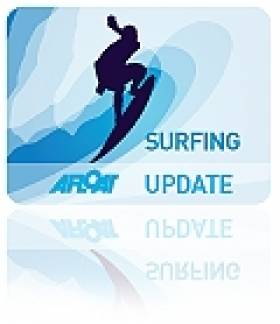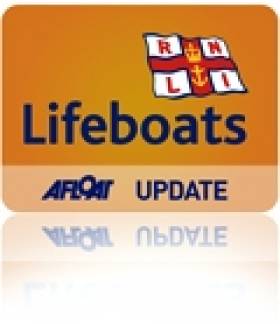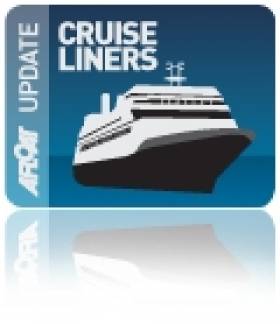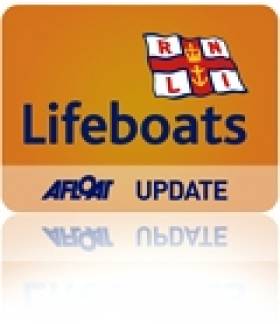Displaying items by tag: Maritime TV Programmes
Leitrim Surfer Learns the Ropes for Reality TV Show
#Surfing - A young surfer from Kinlough talks to the Leitrim Observer about his experiences taking part in the RTÉ series Big Wave Bootcamp, currently showing Fridays at 5pm on RTÉ Two.
Seventeen-year-old Daniel McGlynn was among eight teenagers who were given just three weeks to become expert surfers under the instruction of American surfing professional Ken Bradshaw.
After an audition process for the reality TV series last summer, McGlynn and his fellow teens were flown half-way round the world to Hawaii. But despite the idyllic surroundings, the group faced a punishing training schedule.
“We were in bed at 9 o’clock and up at 6am. We would then train for at least four hours in the day," says McGlynn. "Everything was so much tougher, the waves could be up to 6ft or 7ft tall, even to paddle out on the surf board was a challenge as the current was so much stronger!"
An occasional surfer for almost a decade, McGlynn says he really stepped up his game under the tutelage of Bradshaw.
"He literally taught us everything he knows about the sport, everything. He also rode the biggest wave ever recorded, a massive 86ft in Oahu, Hawaii.”
The Leitrim Observer has more on the story HERE.
River Barrow Features in New Series of 'Abhainn'
#OnTheTV - A new series of Abhainn begins this evening on RTÉ One as the Irish-language TV programme explores Ireland's second-longest river, the River Barrow.
Described by the Kilkenny People as one of Ireland's most picturesque rivers, the programme will follow the near 200km journey from Glenbarrow Waterfall in Laois and along the Kilkenny-Carlow border - stopping along the way at such spots as Cushendale Woolen Mills - till it joins with the Nore at New Ross.
Future editions of the series will focus on the Blackwater and the Erne, taking viewers on a visually stunning journey revealing the unique personality of each river and the stories both ancient and new that tell us who we really are.
The new series of Abhainn begins on RTÉ One tonight Monday 28 January at 7.30pm.
Lough Swilly RNLI Featured On 'Ear to the Ground'
#RNLI - RTÉ’s popular agricultural programme Ear to the Ground paid a visit to Lough Swilly RNLI recently which will feature on this week's episode on Thursday evening.
Set to feature is local man Francis Burns, who along with running a successful farm hoof care business also volunteers with Lough Swilly RNLI’s lifeboat crew.
The programme, which looks at issues concerning agriculture and the rural community, had planned to spend a day with Burns carrying out his job – but when producers heard about his role as a volunteer lifeboat crew member, they decided to include his role with the RNLI too.
Burns and fellow Lough Swilly lifeboat volunteers Eamonn Mahon, Michael Doherty, Tommy Cooper and Francis Bourne showed their guests around the station and demonstrated a lifeboat launch for them.
While most visitors to the station are particularly interested in the RNLI’s Atlantic 85 inshore lifeboat, the Ear to the Ground crew were particularly impressed with the RNLI’s huge custom-built tractor, which the lifeboat crew uses to launch and recover the lifeboat.
The massive tyres are filled with water and antifreeze to make sure it stays on the ground when it enters the water.
Speaking about the filming, Burns said: “I’ve wanted to be a member of Lough Swilly RNLI ever since we got a day off school to come down and see the new all-weather lifeboat arriving at the station.
"Lifeboats are in my family as my cousin George O’Hagan is also the second coxswain on the lifeboat.
"It will be great to be able to show people how lifeboat volunteers can work in the agricultural sector and still be able to train and go out on the lifeboats to help rescue people.”
Programme director Liam Lavelle added: “We are delighted to be able to include the RNLI on Ear to the Ground. It’s a great story about people who volunteer to save lives.
"In our programme we try and reflect what people are doing in rural communities. Many of these communities touch the sea and this work is an important part of Francis’s story."
The programme is due to air on RTÉ One this Thursday evening 31 January at 8.30pm.
Survivors Mark Anniversary of Costa Concordia Tragedy
#CostaConcordia - RTÉ News reports that survivors of the Costa Concordia are joining relatives of the 32 people who died in the tragedy to mark the first anniversary of the shipwreck.
The day-long commemoration began this morning with the return to the sea of the rocks that ripped open the hull of the cruise liner when it ran aground in the shallows off the west coast of Italy.
It will be followed by a Mass and a minute's silence at 9.45pm tonight at the moment when the vessel hit the rocks.
As previously reported on Afloat.ie, an Irish couple were among the thousands rescued from the ship when it capsized off Tuscany on the evening of 13 January 2012.
The ship's crew have been praised for their efforts during the dangerous night-time evacuation of the sinking ship, and received the Lloyd's List Seafarer of the Year award for their "courage and professionalism".
Meanwhile, the ship's captain Francesco Schettino is under house arrest awaiting trial on charges of manslaughter, causing the incident and abandoning ship.
And BBC News reports that the wreck of the Costa Concordia is expected to be removed from the Tuscan coast by September this year.
A documentary on the final moments of passengers on board the stricken cruise liner is available to watch online via Channel 4's 4oD service (UK and Ireland only).
Howth Trawler Assist Features on 'Ireland's Search and Rescue'
#Rescue - The most recent episode of Ireland's Search and Rescue features a combined mission by Howth RNLI and the Irish Coast Guard to aid a fishing vessel off Howth earlier this year.
As previously reported on Afloat.ie, the Howth lifeboat crew spent more than 10 hours on 4 February last assisting the 17-metre trawler, with seven crew on board, which was rapidly taking on water.
The coastguard rescue helicopter was also on scene to help the stricken vessel, winching a salvage pump on board to try to stem the water flow amid difficult weather and sea conditions.
The programme is available online via RTÉ Player until 31 December.
The six-part series on RTÉ One has previously featured exclusive footage of the Tit Bonhomme rescue effort at Glandore Harbour in West Cork last January.
Sole survivor of the tragedy, Abdul Mohammed, spoke to presenter Claire Byrne about his struggle to survive the ordeal that claimed the life of his brother Wael and the four other crew.
TV3 Christmas Special to Feature 'Unsung Heroes' of Arklow RNLI
#RNLI - Volunteers from Arklow RNLI in Co Wicklow are to feature in a Christmas special to be broadcast on TV3.
The documentary, Unsung Heroes, will highlight the efforts of those who provide the essential rescue service throughout the year, including over the festive season.
It will be broadcast twice over Christmas, first at 8pm on Friday 21 December and again at 8pm on Sunday 23 December.
A TV3 film crew spent the morning of Tuesday 27 November at Arklow RNLI filming at what is the oldest of the 44 lifeboat stations in Ireland.
Producer Patrick Kinsella and cameraman Vinnie Broderick shadowed the volunteers on a training-based exercise when they launched their all-weather Trent class lifeboat, the Ger Tiighcelarr.
"The documentary is about unsung heroes," said Kinsella, "and I suppose given my own experience having worked in the shipping industry, I feel the RNLI and its people – the men and women who run and manage this organisation - cannot be praised enough for putting their lives at risk to save others, and I think this programme is a good way to shine a light on the work they do."
During the exercise, Kinsella and Broderick had the opportunity to experience first-hand and get a glimpse of the level of training required by RNLI volunteers to become highly skilled and efficient in order to carry out lifesaving work which can often be difficult and sometimes dangerous.
Interviews were carried out with lifeboat operations manager Jimmy Tyrell, coxswain Ned Dillon and volunteer crew member Stephen Furlong. Tyrell said filming with TV3 was a great opportunity to showcase the commitment of volunteers, not only in Arklow but in the many other coastal and inland water communities across Ireland.
He said the RNLI wouldn’t exist without fundraising, adding that the charity was totally reliant on the generosity of the public and indebted to work of fundraisers at station branches as well as those raising money inland.
Tyrell also said crew members would happily exchange their Christmas dinner and the comfort of their homes should the need arise this year to help anyone who may find themselves in difficulty at sea.
"It is because of the willingness and selfless nature of our volunteers, who will readily swap leisure, comfort and sleep for cold, wet and fatigue that the charity can provide an on-call, 24-hour lifeboat search and rescue service here," he said. "The RNLI depends on its volunteers who give their time, skill and commitment, even at Christmas time.
"Indeed, while our lifeboats are busy all year round, some of the most challenging callouts can occur over the winter months. And while most of us will be enjoying the Christmas festivities with our loved ones, we know that somewhere, RNLI lifeboats will be launched to help save lives at sea."
Bass Angling Feature on Tonight's 'Ear to the Ground'
#ON THE TV - Tonight's episode of Ear to the Ground on RTÉ One will feature a report on bass angling in Ireland, and the commercial fishing sector's efforts to re-open bass fisheries.
Among those interviewed for the feature were Dr Ed Fahy, who gave a talk at the recent Hook Bass Angling Festival discussing the threat to Ireland's sea bass should the fishery be opened to commercial interests, and argueing the case for bass angling tourism as a greater boon for the economy.
Ear to the Ground is broadcast tonight at 8.30pm on RTÉ One.
Exclusive Footage of Tit Bonhomme Rescue on RTÉ
#MARITIME TV PROGRAMMES - Footage from the rescue of the only survivor of the Tit Bonhomme tragedy in West Cork last January will feature in the first of a new series of Ireland's Search and Rescue tomorrow evening on RTÉ One.
Abdul Mohammed, 43, survived the sinking of the trawler when it ran around in rough seas near Adam's Rock at Glandore Harbour, after he was able to reach the shore.
His brother Wael Mohammed (35) died along with skipper Michael Hayes (52), Saied Ali Edlin (26), Attea Shaban (26) and Kevin Kershaw (21) when the boat went down.
As the Southern Star reports, Mohammed will feature in Sunday's programme talking to presenter Claire Byrne about his struggle to survive the tragedy, while exclusive footage from the Irish Coast Guard's Rescue 117 helicopter, the Irish naval vessel LE Niamh and Naval Service divers shows the search for the missing fisherman in the wake of the incident - a first for Irish television.
The first episode of the six-part series will be broadcast this Sunday 18 November at 6.30pm on RTÉ One.
Ar an Oileán (On the Island)
#ISLANDS ON TV – A new four-part series Ar an Oileán (On the Island) begins next Monday (12 November) on RTE 1 at 7.30pm.
The series focuses on two islands, the West Cork island of Cape Clear Island and Inis Meáin, the central island of the Aran Islands, marking the western approaches of Galway Bay.
By following the stories of islanders filmed over an entire year, we are given an opportunity to understand what makes these places unique.
In addition a glimpse into contemporary island life will be explored throughout the seasons.What it really means to live on a 'real' island through the various difficulties encountered, the inevitable heartaches but also the beauty and the sense of community that only island life can offer. Episode One will cover school days, blow-ins and a wedding.
Living the Wildlife Visits 'Underwater Ireland'
#DIVING ON TV - The latest episode of RTÉ One's natural history series Living the Wildlife takes a look at the secrets of 'Underwater Ireland'.
Presenter Colin Stafford-Jones goes diving with renowned underwater wildlife photographer Nigel Motyer, who has had photographs published in National Geographic magazine, to find a conger eel in Killary Harbour, Co Mayo.
Killary is Ireland's only fjord, which means that diving is possible all year round. But SCUBA diving is not the only way to access the underwater world - snorkelling is a cheaper and more practical way, as Victor Kutischev of the website Underwater Ireland demonstrates.
"Victor has seen some remarkable things over the last few years," says Stafford-Jones. "The triggerfish he filmed in Kerry, which we see in the show look absolutely extraordinary; it makes me want to throw on a mask and snorkel right now."
Stafford-Jones also visits old friend Dave Tilley on Sandymount Strand in Dublin Bay, where he shows how to gather a sustainable lunch from the clean waters of the bay - such as the razor clams regularly found on our beaches.
Catch the programme again tomorrow night (Monday 5 November) at 8.30pm on RTÉ One, or click HERE to view via RTÉ Player (available till 22 November in Ireland only).






































































